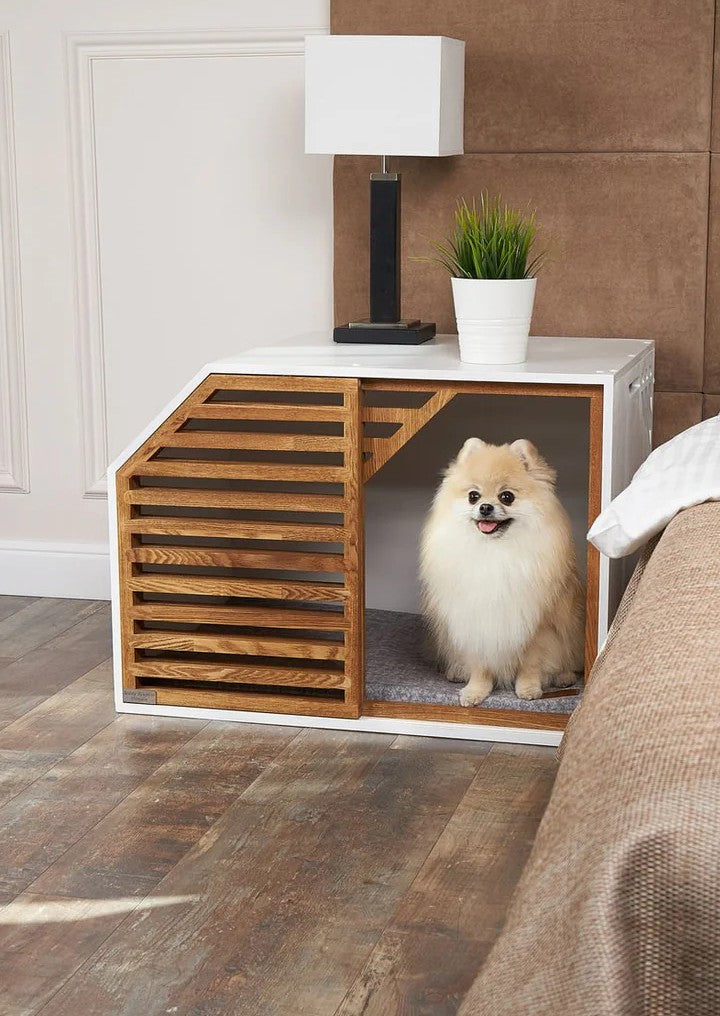Bringing a new puppy into your home is an exciting experience, but it also comes with responsibilities, especially during the first month. One of the biggest challenges new puppy parents face is figuring out how to leave their furry friend home alone while balancing work or other commitments. In this blog, we'll explore some essential tips to help you care for your puppy during those early weeks, ensuring they feel safe, comfortable, and loved even when you're not there.
Preparing to Leave Your Puppy at Home
Leaving your puppy alone for the first time can be nerve-wracking, but with proper preparation, it doesn't have to be stressful. Puppies, like human babies, require a safe and secure environment where they can rest, play, and stay calm. Here's what to do with a puppy while at work:
- Set up a Comfortable Space:Creating a designated area for your puppy is crucial. Consider using modern puppy crates or a small wooden dog house to provide a cozy spot for your pup. These spaces should be big enough for your puppy to stand, turn around, and lie down comfortably. A dog cage for the house can also be a great option, especially for breeds that may feel anxious in larger spaces.
- Provide Essential Items: Stock your puppy's space with things they will need. This includes a comfortable dog bed, chew toys to keep them entertained, and food and water to keep them nourished. These items not only cater to their physical needs but also help them feel more secure and less anxious when left alone. It is important to choose the right crate size for your pet.
Tips for Leaving Your Puppy Alone
Once your puppy's space is set up, there are several steps you can take to ensure they feel safe and calm while you're away.
- Start Slowly: If possible, gradually acclimate your puppy to being alone by leaving them for short periods before extending the time. This can help them adjust to the routine without becoming overly anxious.
- Establish a Routine: Puppies thrive on routine. Feeding, bathroom breaks, and playtime should occur at regular intervals. A consistent schedule helps your puppy know what to expect, reducing anxiety when they're left alone.
- Interactive Toys: Interactive toys are a great way to keep your puppy occupied and mentally stimulated while you're away. Puzzle toys filled with treats can keep your puppy engaged and prevent boredom.
- Consider a Dog House for Puppies: For outdoor breeds, a crate for puppies might be an option. However, make sure it's a safe and secure environment with proper insulation and ventilation. For indoor breeds, a puppy house can serve as a cozy retreat within your home.
- Monitor Through Technology: Pet cameras allow you to check in on your puppy throughout the day. This can provide peace of mind and help you understand how your puppy behaves when left alone.
Crate Training: An Essential Tool
Crate training can be incredibly beneficial for both you and your puppy. Modern puppy crates offer a safe and comfortable space where your puppy can retreat when they need some alone time. Here are some tips for successful crate training:
- Make the Crate Inviting: Place soft bedding, toys, and a few treats inside the crate. This helps your puppy associate the crate with positive experiences.
- Use the Crate Gradually: Start by leaving the crate door open so your puppy can explore it freely. Over time, begin closing the door for short periods, gradually increasing the duration as your puppy becomes more comfortable.
- Never Use the Crate for Punishment: The crate should always be a safe space, not a place of fear. Ensure your puppy only has positive associations with their crate.
Leaving your puppy at home during work can be challenging, but with careful planning and the right tools, you can ensure your pup feels safe, comfortable, and loved even when you're not there. Whether you're using a modern puppy crate, a small wooden dog house, or a dog cage for the house, the key is to create a secure environment that meets your puppy's needs. With patience, consistency, and plenty of love, your puppy will quickly adapt to their new routine and thrive in your home.

